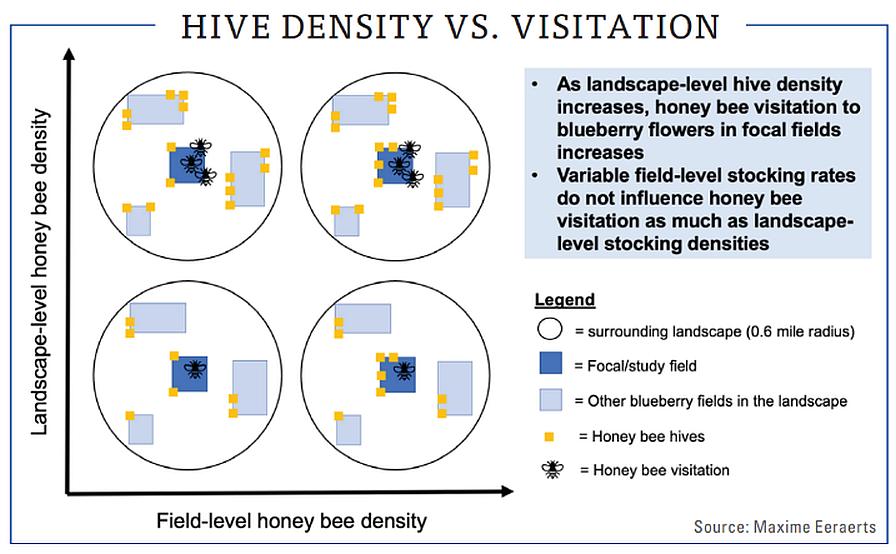Ways the Landscape Can Impact Blueberry Pollination
Every year, commercial blueberry growers face the question of how many honey bee hives to stock their fields with to maximize pollination. The answer seems to lie beyond their field edges, in the complex patchwork of the surrounding landscape. More than 75% of crops produced globally depend on insect pollination. Of these crops, many are pollinated by managed honey bees by placing rented hives in the field during crop flowering.
Blueberry is one of several crops that depends on insect-mediated pollination, but the question of how many honey bee hives to stock in a field to attain optimal pollination is a complex one that researchers and growers alike are attempting to untangle.
THE BUZZ ON STOCKING DENSITIES
There have been many studies on field-level honey bee stocking densities in blueberry and other crops, but little research has been conducted on a larger landscape scale beyond a field’s edge. Given that the foraging radius of a honey bee is 1,000 to 2,000 meters (0.6 to 1.2 miles) or sometimes even greater, field-level stocking rates may miss contributions of other honey bees in the landscape that could contribute to blueberry pollination. Growers also have expressed concern that honey bees forage outside of their fields, which sometimes leads them to increase stocking rates to ensure pollination in their own fields.
All of this inspired our team to look beyond the field’s edge to better understand blueberry pollination.
We recently completed a study that illuminates the role of the wider landscape context on blueberry pollination and yield. In an experiment completed in Northwestern Washington across 16 blueberry fields, our results show the density of hives within a 1,000 meter (0.6 mile)-landscape radius best predicts honey bee visitation to blueberry flowers in our statistical models. In contrast, field-level stocking densities poorly predict honey bee visitation. This suggests that field-level stocking density recommendations neglect contributions from other hives in the landscape. Furthermore, we found that as the proportion of blueberry in the landscape around a field increases, the number of honey bee hives increases as well.

Both findings may seem fairly simple and intuitive. But they have gone unstudied in pollination research. Revising honey bee stocking density recommendations to consider contributions of honey bees in the broader landscape around an individual field will require collaboration among beekeepers, growers, and crop consultants, which may be difficult to achieve. If successful, though, financial and ecological repercussions of over- or under-stocking fields can be avoided, and optimal pollination can be achieved.
BEYOND HONEY BEES
In the Pacific Northwest, populations of wild pollinators (bumblebees and solitary bees) are usually smaller than the massive number of honey bees growers bring in. Yet wild pollinators can still contribute meaningfully to pollination, as they tend to be more efficient pollinators of blueberry. Therefore, it was also important for us to evaluate landscape effects on wild pollinators. We found that as the amount of semi-natural habitat increased around a field, more wild bees pollinate blueberry fields. In contrast, honey bee visitation was not affected by more or less semi-natural habitat. Again, this finding is simple and intuitive, but helps paint a picture of where pollinators are in the landscape and informs pollination strategies.
Growers looking to enhance wild pollinator populations should conserve or create habitat around their fields. Minimally disturbed hedgerows with flowering woody and herbaceous plants (e.g., willow and clover), as well as flower strips, are examples of habitats beneficial to wild pollinators. Providing habitat will also be beneficial to honey bees through the provision of a more diverse and nutritious diet from other flower resources. This in turn can boost their honey production, colony health, and pollination contribution later in the year as they move to different crops.
When combined with landscape-driven honey bee stocking densities, appropriately stocked farms should be able to strike a balance between meeting crop pollination needs and growers’ budgets. This should also, in turn, reduce competition for floral resources among wild pollinators and overly abundant honey bees.
In conclusion, looking at landscapes beyond the field edge provides a more comprehensive understanding of crop pollination dynamics and will be powerful to leverage in order to inform sustainable pollination strategies. Next steps will entail determining the optimal colony density on a landscape scale to inform growers on how to stock their fields and prevent overstocking.









